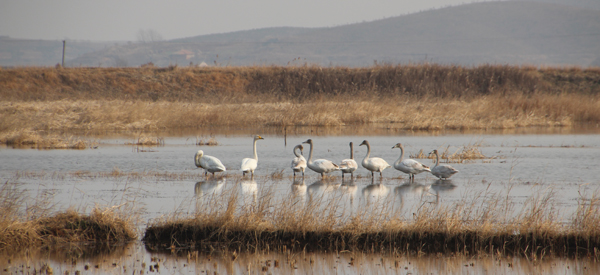
This family of Whooper Swans, including a pair with their six cygnets, was not afraid when I approached
for a picture, confirming that the local farmers do not harass birds.
By Dr. George Archibald, ICF Co-founder & Senior Conservationist
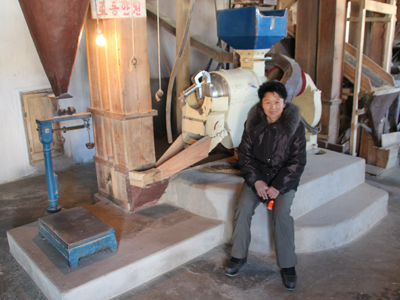
In late November, I traveled to the Hermit Kingdom (the Democratic People’s Republic of Korea – DPRK) to provide ICF support for the work of my excellent colleagues at the State Academy of Sciences and the farmers at two important wintering sites for Red-crowned Cranes. Under the canopy of BirdLife International, and with my Canadian passport, since 2008 we have been able to help colleagues in North Korea initiate a long-term process of restoring conditions for cranes by first helping farmers in areas where Red-crowned Cranes wintered prior to the widespread food shortages for humans during the 1990s. In winter, these cranes often feed on gleanings in fields where crops have been harvested. So, return of the cranes is predicated upon first restoring agricultural production.
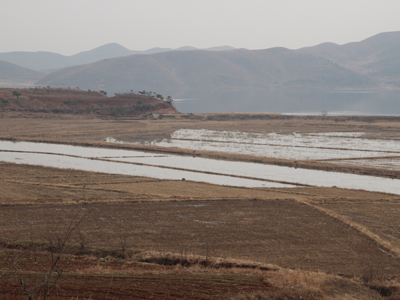
We selected Pisan Cooperative Farm (PCF) on the Anbyon Plains of southeastern North Korea for our demonstration project. Drought, floods and shortages of chemical fertilizers in the 1990s created the crisis for humans and precipitated the departure of cranes for better habitat in the Demilitarized Zone (DMZ) and rice fields within the uninhabited Civilian Controlled Zone that borders the DMZ in the Cheorwon Basin of South Korea. But to help the cranes, we must first help the farmers. I am pleased to report that the organic farming practices now implemented at PCF have resulted in bumper yields; soil there continues to become richer; and rice has superior taste.
The manager of the farm, Mrs. Kim Yon Sin, is thrilled. And the cranes are responding as well. In November and December 2013, 35 cranes landed at the PCF from the 194 that had flown over. Now the challenge is getting the cranes to stay. Attendants lead herds of goats and cattle and flocks of ducks and geese over the harvested fields and disturb the cranes. Sixty-two hectares of rice paddies near the Namdae River (where cranes roost), have been designed by the government as a Crane Refuge. Our North Korean colleagues’ task in 2014 is to fence the area in with poultry netting and plant willows around the refuge so the cranes are assured food and freedom from disturbance.
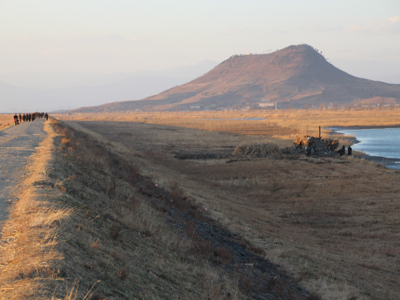
will be protected in the near future.
This success on the Anbyon Plain has opened the way for ICF to help in other areas of North Korea where cranes currently and formerly wintered. These include wetlands around a reservoir and on tidal mudflats in Kangryong District in the southwest, where as many as 80 cranes once wintered, but where only three were observed the previous winter. In addition, farmers last year reported eight cranes wintering in Tae Tan County just west of Kangryong. The soil is less fertile in coastal areas of the southwest, and productivity of crops is greatly reduced from that on the Anbyon Plain. But they have cranes! Consequently, our DPRK colleague, Dr. Pak U Il hopes to help the local people and thus the cranes in those areas as well. And there are reports of as many as 120 White-naped Cranes wintering on estuarine wetlands of Pae Chon County, along the western portion
of the DMZ just across from Gangwha Island of South Korea.
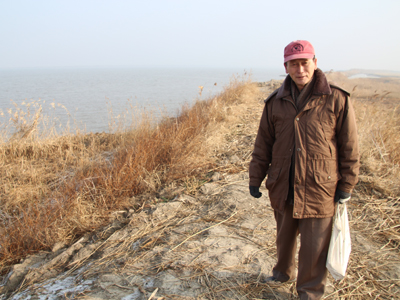
In addition to the wintering sites, we were able to visit two migration resting areas, one midway up the west coast, the Mundok wetlands, and one midway up the east coast, the Kumya wetlands. Wetlands in both areas are a consequence of the productivity of mudflats and reed beds associated with the river estuaries. Although it was too late to encounter migrating cranes, we were exhilarated to see many thousands of Swan Geese and mallards on the Mundok wetland. To the chagrin of Dr. Pak, many of the wetlands of the Kumya estuary have been converted to paddocks for salt production. He will now work with the local authorizes to provide more secure protection for remaining wetlands.
It is a great pleasure to work with Dr. Pak. As well as being the dean of ornithology in North Korea, in recent years he has made a comprehensive study of biodiversity conservation, organic farming, alternative fuels and reforestation. To help the farmers, he has published and distributed the definitive book on organic farming practices applicable to North Korea. He recently published a large volume on the conservation of biodiversity. And he is working on another book about alternative fuels. Realizing the impacts of the likes of John Muir and Aldo Leopold on conservation values in North America and elsewhere, I encouraged Dr. Pak to write a book about environmental values for the lay reader in North Korea to increase their knowledge of and sensitivity to the importance of the world of nature we all share. In the near future I hope to send Dr. Pak some quotes from our leaders in environmental thought, to help him create a story that will touch the hearts throughout the divided peninsula.
